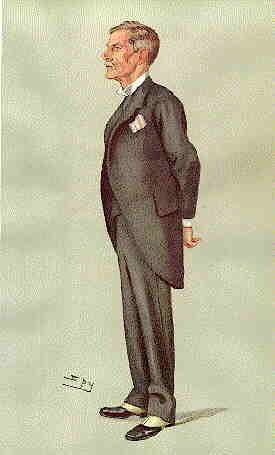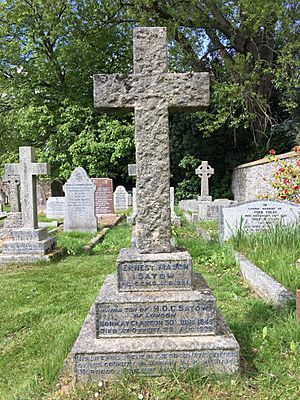Ernest Mason Satow facts for kids
Quick facts for kids
Sir Ernest Mason Satow
|
|
|---|---|
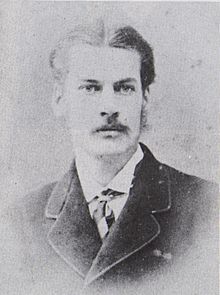
The young Ernest Mason Satow. Photograph taken in Paris, December 1869.
|
|
| British Minister to Japan | |
| In office 1895–1900 |
|
| Monarch | Victoria |
| Prime Minister | The Marquess of Salisbury |
| Preceded by | Power Henry Le Poer Trench |
| Succeeded by | Sir Claude Maxwell MacDonald |
| Personal details | |
| Born | 30 June 1843 Clapton, London, England |
| Died | 26 August 1929 (aged 86) Ottery St Mary, England |
| Resting place | Ottery St Mary Parish Churchyard, Ottery St Mary, England |
| Spouses | Takeda Kane (1853–1932) |
| Children |
|
| Parents |
|
| Education | Mill Hill School University College London |
| Occupation | Diplomat |
Sir Ernest Mason Satow (born June 30, 1843 – died August 26, 1929) was a very important British diplomat. A diplomat is someone who represents their country in other nations. He was also a scholar, meaning he studied many things, and a Japanologist, someone who deeply understands Japan.
Satow is much more famous in Japan than in Britain. In Japan, he was known as Satō Ainosuke. He played a big role in the relationship between Britain and Japan. This was especially true during the Bakumatsu (1853–1867) and Meiji-period (1868–1912) eras in Japan. He was also important in China after the Boxer Rebellion (1900–1906). Satow also worked in Siam, Uruguay, and Morocco. He even represented Britain at a major peace meeting in 1907. Later in life, he wrote a famous book called A Guide to Diplomatic Practice. This book is still used by diplomats today.
Contents
Early Life and Education
Ernest Satow was born in Clapton, North London. His father, Hans David Christoph Satow, was German but became a British citizen. His mother, Margaret Mason, was English.
Ernest went to Mill Hill School and then University College London (UCL). He was incredibly good at learning languages. He loved to travel, write guidebooks, and create dictionaries. He was also a mountaineer and a keen botanist, someone who studies plants. Satow collected many Japanese books and manuscripts. He also enjoyed classical music and the works of the famous writer Dante. Satow kept a detailed diary for most of his life, filling 47 handwritten books.
Satow's Diplomatic Career
Working in Japan (1862–1883)
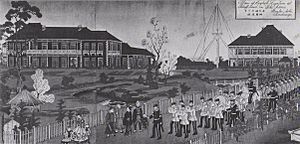
Ernest Satow is perhaps best known for his book A Diplomat in Japan. This book tells the story of his time in Japan from 1862 to 1869. During these years, Japan was changing from being ruled by the Tokugawa shogunate to having the Emperor back in charge.
Satow joined the British Foreign Office right after university. He arrived in Japan as a young student interpreter when he was just 19 years old. Soon after he arrived, a British merchant was killed in an event called the Namamugi Incident. Satow was on a British ship that sailed to Kagoshima in 1863. They went to get payment from the Satsuma clan for the killing. The Satsuma shore batteries fired at them, and the British ships fired back, bombarding Kagoshima.
In 1864, Satow joined a group of forces from Britain, France, the Netherlands, and the United States. They attacked Shimonoseki to make sure foreign ships could pass through the Kanmon Straits. Satow met important Japanese leaders like Itō Hirobumi and Inoue Kaoru before this attack. He also became friends with other leaders, including Saigō Takamori. He traveled around Japan with A. B. Mitford and the artist Charles Wirgman.
Satow quickly became important in the British consular service. This was because he was a skilled interpreter. At that time, very few Japanese people spoke English. The Japanese government often communicated with Westerners in Dutch. Satow's language skills were vital for the British Minister, Sir Harry Smith Parkes. He helped Parkes talk with the Japanese government and powerful clans like Satsuma and Chōshū. Satow was promoted to full Interpreter and then to Japanese Secretary. By 1864, he was writing translations and newspaper articles about Japan.
In 1872, Satow helped start the Asiatic Society of Japan in Yokohama. This group aimed to study Japanese culture, history, and language. Satow gave many talks to the Society. His articles, like one from 1874 about Japan in the New American Cyclopædia, were among the first accurate writings about Japan in European languages. This Society is still active today.
Satow also spent a lot of time studying Chinese calligraphy. He even received an artist's name, Seizan, in 1873. The British Library now has an example of his calligraphy.
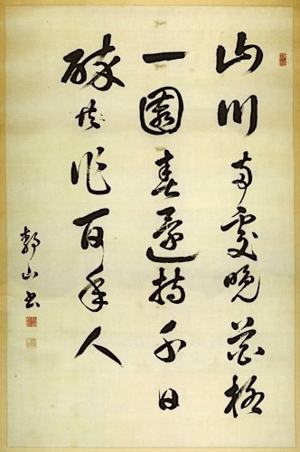
Working in Other Countries (1884–1895)
After his time in Japan, Satow worked in Siam from 1884 to 1887. During this time, he was given a special promotion from the Consular Service to the Diplomatic Service. This was unusual because these two services were separate back then. He then served in Uruguay (1889–1893) and Morocco (1893–1895).
Return to Japan (1895–1900)
Satow came back to Japan as a top diplomat, the Envoy Extraordinary and Minister Plenipotentiary, on July 28, 1895. He stayed in Tokyo for five years. He saw Japan building up its army and navy. This was to get revenge for the Triple Intervention of 1895. In this event, Russia, Germany, and France forced Japan to give up some land it had won.
Satow also helped oversee the end of extraterritoriality in Japan in 1899. This meant that foreigners in Japan would now be judged by Japanese laws, not their own country's laws. This change was agreed upon in the Anglo-Japanese Treaty of Commerce and Navigation in 1894.
Satow built a house at Lake Chūzenji in 1896. He often went there to relax from his busy work in Tokyo. He was not named the first British Ambassador to Japan. That honor went to his successor, Sir Claude Maxwell MacDonald, in 1905.
Working in China (1900–1906)
Satow served as the British High Commissioner and then Minister in Peking from 1900 to 1906. He was very active in the talks to create the Boxer Protocol. This agreement settled the money claims of different countries after the Boxer Rebellion. He signed the protocol for Britain on September 7, 1901. He also watched Russia's defeat in the Russo-Japanese War (1904–1905) from his post in Peking.
Retirement (1906–1929)
In 1906, Satow became a Privy Councillor. In 1907, he was Britain's second representative at the Second Hague Peace Conference, a meeting about international peace.
After he retired in 1906, Satow lived in Ottery St Mary in England. He spent his time writing about diplomacy and international law. In Britain, he is not as well known as he is in Japan. In Japan, he is seen as one of the most important foreign observers of the Bakumatsu and Meiji periods.
Satow's understanding of the Japanese people grew over time. Early in his career, he thought it would be easy for foreigners to govern Japan. But later in life, he wrote that this idea was "perfectly ludicrous" for anyone who understood the "Japanese spirit."
Satow's many diaries and letters are kept at The National Archives in London. Many of his rare Japanese books are now in the Cambridge University Library. His collection of Japanese prints is in the British Museum.
He passed away on August 26, 1929, in Ottery St Mary. He is buried in the churchyard of St Mary's Church, Ottery St Mary.
Family Life
As a diplomat, Satow was not able to officially marry his Japanese partner, Takeda Kane (1853–1932). They met at an unknown time. They had a daughter who was born and died in 1872. Later, they had two sons, Eitaro (born 1880) and Hisayoshi (born 1883). Eitaro sadly passed away before his father.
Satow's second son, Takeda Hisayoshi, became a famous botanist. He founded the Japan Natural History Society. He also served as President of the Japan Alpine Club from 1948 to 1951. He studied at the Royal Botanic Gardens, Kew and at Birmingham University. There is a memorial hall for him in the Oze marshlands in Japan.
The letters from the Takeda family, including many of Satow's letters to his family, are kept at the Yokohama Archives of History.
Selected Writings
- A Handbook for Travellers in Central and Northern Japan (1881, 1884) – A travel guide he wrote with A. G. S. Hawes.
- A Guide to Diplomatic Practice (1917) – This is a very important book about how diplomats should do their job. It is still used today.
- A Diplomat in Japan (1921) – This book is based on his diaries and tells about his early years in Japan.
- The Voyage of John Saris (1900) – A historical work he edited.
Dramatization
In September 1992, BBC Two showed a two-part TV show about Satow's life. It was called A Diplomat in Japan. It starred Alan Parnaby as Satow. Ernest Satow also appears in the 2023 video game Ryū ga Gotoku Ishin!. In the game, he asks the main character to collect stories about Japan.
See also
 In Spanish: Ernest Mason Satow para niños
In Spanish: Ernest Mason Satow para niños
- List of Ambassadors from the United Kingdom to Japan
- Anglo-Japanese relations
- Anglo-Chinese relations
- Asiatic Society of Japan
- Yokohama Archives of History
- Sakoku
- List of Westerners who visited Japan before 1868
- Empress Dowager Cixi
- Chōshū Five
People who knew Satow
|
|
Images for kids
-
Poem by the Tang poet Wang Bo 王勃 (650–676) in Satow's calligraphy (British Library Or. 16054)


